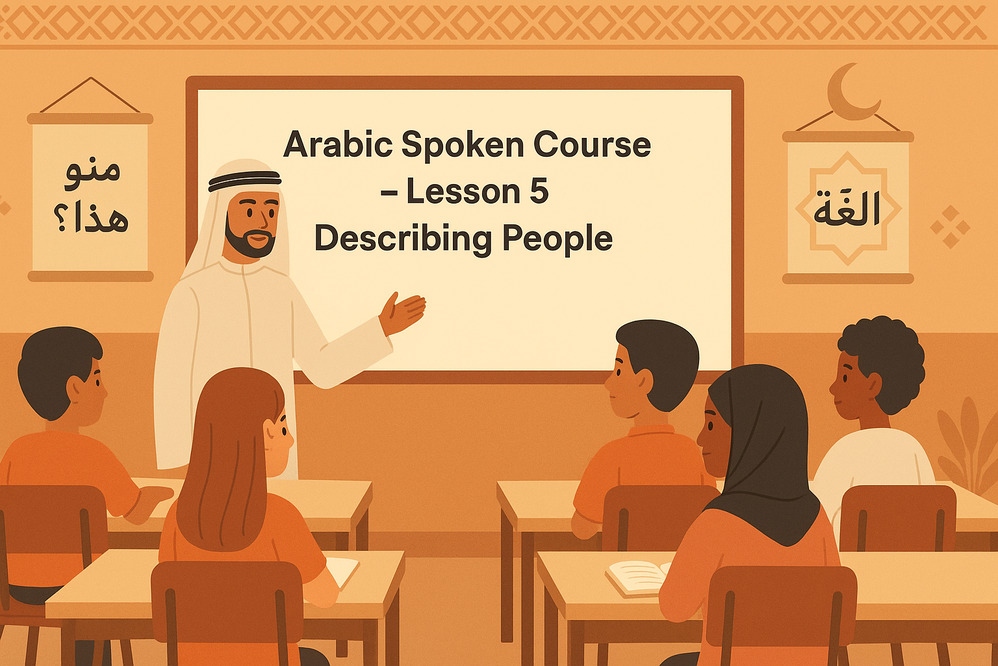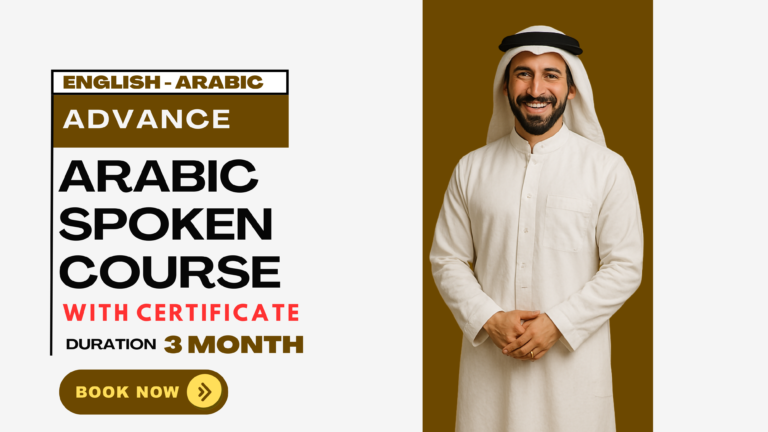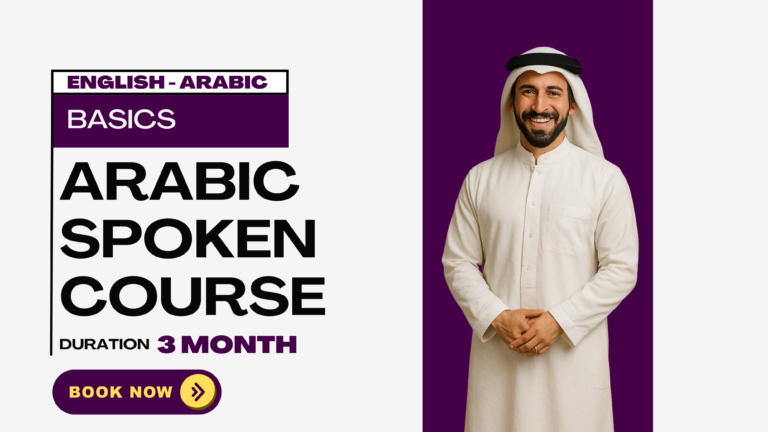Introduction: Why Describing People Is a Game-Changer in Arabic
Imagine you’re in the Gulf – maybe Kuwait, the UAE, or Saudi Arabia – and someone asks you: “Who is Ahmad?” You want to say, “He’s tall, friendly, and has curly hair.” But your mind goes blank.
This is where Lesson 5 of our Arabic Spoken Course comes in. Describing people isn’t just about vocabulary—it’s about connecting with others, painting pictures with words, and building confidence in real conversations.
In this lesson, you’ll master common Gulf Arabic expressions to describe appearance and personality traits. We’ll break it down into easy chunks—with real conversations, vocabulary tables, and word-by-word analysis.
Let’s get you speaking like a local 🇸🇦🇦🇪🇰🇼!
Why This Lesson Matters
Describing people is a core skill in Arabic conversation, especially in social situations, introductions, or job interviews.
You’ll learn to:
- Talk about how someone looks (height, hair, age)
- Describe personality traits (friendly, smart, shy)
- Use Gulf Arabic expressions you won’t find in textbooks
- Practice real-life dialogues with word-by-word breakdowns
Part 1: Describing Physical Appearance (المظهر)
Here’s a table of the most useful words to describe how someone looks, especially in Gulf Arabic:
| Emoji | Arabic Script | Roman Arabic (Gulf) | English | Roman Hindi/Urdu |
|---|---|---|---|---|
| 👨🦱 | شعر مجعّد | shaʿr mujaʿʿad | Curly hair | ghungraale baal |
| 👩🦰 | شعر ناعم | shaʿr nāʿim | Straight hair | seedhe baal |
| 👴 | كبير في السن | kabīr fil sinn | Old | buzurg |
| 👦 | صغير | ṣaghīr | Young | chhota |
| 📏 | طويل | ṭawīl | Tall | lamba |
| 📏 | قصير | qaṣīr | Short | chhota |
| 👀 | عيونه كبار | ʿuyūnah kibār | Big eyes | badee aankhen |
| 👃 | خشمه صغير | khashmah ṣaghīr | Small nose | chhoti naak |
| 🧔 | لحيته كثيفة | laḥyatah kathīfah | Thick beard | ghani daadhi |
Note: In the Gulf, you’ll often hear:
- Kibār (كبار) instead of kabīrah for “big”
- Khashm (خشم) instead of anf (أنف) for “nose”
✅ These are local Gulf variations that make you sound more natural.
Part 2: Describing Personality (الشخصية)
Let’s explore common words to describe someone’s character or behavior:
| Emoji | Arabic Script | Roman Arabic (Gulf) | English | Roman Hindi/Urdu |
|---|---|---|---|---|
| 😄 | طيب | ṭayyib | Kind | nek |
| 😊 | ودود | wadūd | Friendly | dostana |
| 🧠 | ذكي | dhakī | Smart | samajhdaar |
| 🤫 | خجول | khajūl | Shy | sharmaila |
| 🗣️ | ثرثار | tharthār | Talkative | bakbakoo |
| 💪 | شجاع | shujāʿ | Brave | bahadur |
| 🙄 | مغرور | maghrūr | Arrogant | ghamandi |
| 🤗 | اجتماعي | ijtimāʿī | Social | milansaar |
| 😎 | هادئ | hādiʾ | Calm | shaant |
These traits are commonly used in casual Gulf conversations—especially when introducing someone, expressing opinions, or making new friends.
Grammar Focus: Adjective Agreement
In Arabic, adjectives agree in gender and number with the noun they describe:
| Example | Gender | Translation |
|---|---|---|
| رجل طويل | rajul ṭawīl | A tall man (masculine) |
| بنت طويلة | bint ṭawīlah | A tall girl (feminine) |
| عيون جميلة | ʿuyūn jamīlah | Beautiful eyes (plural) |
👉 Tip: Most feminine adjectives end in ـة (–ah sound).
Real Conversation Example – Describing Someone
10 Conversations in Gulf Arabic – With Word-by-Word Analysis
Conversation 1 – Talking About a Friend
Asim: منو هذا؟
Meraj: هذا خالد. قصير بس قوي.
Roman Arabic:
Asim: minū hādhā?
Meraj: hādhā Khālid. qaṣīr bas qawī.
English:
Asim: Who’s that?
Meraj: That’s Khalid. He’s short but strong.
| Arabic | Roman | English |
|---|---|---|
| منو | minū | Who |
| هذا | hādhā | This |
| خالد | Khālid | (name) |
| قصير | qaṣīr | Short |
| بس | bas | But |
| قوي | qawī | Strong |
Conversation 2 – Describing a Sister
A: شلون أختك؟
B: أختي هادية ودايم تساعد الكل.
Roman Arabic:
A: shlōn ukhtik?
B: ukhtī hādiyah w dāyim tisāʿid il-kil.
English:
A: How’s your sister?
B: She’s calm and always helps everyone.
| Arabic | Roman | English |
|---|---|---|
| شلون | shlōn | How |
| أختك | ukhtik | Your sister |
| هادية | hādiyah | Calm |
| دايم | dāyim | Always |
| تساعد | tisāʿid | Helps |
| الكل | il-kil | Everyone |
Conversation 3 – Appearance at a Party
Asiya: شفت البنت اللي لابسة أحمر؟
Bano: إي، شعرها طويل وناعم.
Roman Arabic:
Asiya: shift il-bint illī lābsah aḥmar?
Bano: ē, shaʿrahā ṭawīl w nāʿim.
English:
Asiya: Did you see the girl in red?
Bano: Yes, her hair is long and straight.
| Arabic | Roman | English |
|---|---|---|
| شفت | shift | Did you see |
| البنت | il-bint | The girl |
| اللي | illī | Who |
| لابسة | lābsah | Wearing |
| أحمر | aḥmar | Red |
| شعرها | shaʿrahā | Her hair |
| طويل | ṭawīl | Long |
| ناعم | nāʿim | Straight |
Conversation 4 – Talking About Personality
A: تحب مريم؟
B: وايد، لأنها طيبة ومتواضعة.
Roman Arabic:
A: tiḥibb Maryam?
B: wāyid, li’annahā ṭayyibah w mitwāḍiʿah.
English:
A: Do you like Maryam?
B: A lot. She’s kind and humble.
| Arabic | Roman | English |
|---|---|---|
| تحب | tiḥibb | Do you like |
| مريم | Maryam | (name) |
| وايد | wāyid | A lot |
| لأنها | li’annahā | Because she |
| طيبة | ṭayyibah | Kind |
| متواضعة | mitwāḍiʿah | Humble |
Conversation 5 – Making a New Friend
A: منو رفيجك؟
B: هذا أحمد، ودود ودايم يضحك.
Roman Arabic:
A: minū rafījik?
B: hādhā Aḥmad, wadūd w dāyim yaḍḥak.
English:
A: Who’s your friend?
B: This is Ahmad. He’s friendly and always laughs.
| Arabic | Roman | English |
|---|---|---|
| منو | minū | Who |
| رفيجك | rafījik | Your friend |
| هذا | hādhā | This |
| أحمد | Aḥmad | (name) |
| ودود | wadūd | Friendly |
| دايم | dāyim | Always |
| يضحك | yaḍḥak | Laughs |
Conversation 6 – Judging by Looks
A: شكله عصبي؟
B: لا، هادئ مرة.
Roman Arabic:
A: shaklah ʿaṣabī?
B: lā, hādiʾ marrah.
English:
A: Does he look angry?
B: No, he’s very calm.
| Arabic | Roman | English |
|---|---|---|
| شكله | shaklah | He looks |
| عصبي | ʿaṣabī | Angry |
| لا | lā | No |
| هادئ | hādiʾ | Calm |
| مرة | marrah | Very (Gulf slang for “very”) |
Conversation 7 – Personality at Work
A: كيف مديرك؟
B: شوي مغرور، بس شاطر في شغله.
Roman Arabic:
A: kayf mudīrak?
B: shway maghrūr, bas shāṭir fī shughlah.
English:
A: How’s your boss?
B: A bit arrogant, but good at his work.
| Arabic | Roman | English |
|---|---|---|
| كيف | kayf | How |
| مديرك | mudīrak | Your boss |
| شوي | shway | A bit |
| مغرور | maghrūr | Arrogant |
| بس | bas | But |
| شاطر | shāṭir | Good/Smart |
| في شغله | fī shughlah | At his work |
Conversation 8 – Describing a Child
A: ولدك يشبهك؟
B: شوي، بس هو أشقر وأنا لا.
Roman Arabic:
A: waladak yishbahak?
B: shway, bas huwa ashqar w anā lā.
English:
A: Does your son look like you?
B: A bit, but he’s blond and I’m not.
| Arabic | Roman | English |
|---|---|---|
| ولدك | waladak | Your son |
| يشبهك | yishbahak | Looks like you |
| شوي | shway | A little |
| بس | bas | But |
| هو | huwa | He |
| أشقر | ashqar | Blond |
| أنا | anā | I |
| لا | lā | No/Not |
Conversation 9 – Noticing Eyes
A: عيونها حلوة!
B: إي، كبار وسود.
Roman Arabic:
A: ʿuyūnhā ḥilwah!
B: ē, kibār w sūd.
English:
A: Her eyes are beautiful!
B: Yeah, big and black.
| Arabic | Roman | English |
|---|---|---|
| عيونها | ʿuyūnhā | Her eyes |
| حلوة | ḥilwah | Beautiful |
| إي | ē | Yes |
| كبار | kibār | Big |
| وسود | w sūd | And black |
Conversation 10 – Complimenting a Student
A: منو الطالب المجتهد؟
B: سالم، هادي وذكي.
Roman Arabic:
A: minū iṭ-ṭālib il-mujtahid?
B: Sālim, hādī w dhakī.
English:
A: Who’s the hardworking student?
B: Salem. He’s calm and smart.
| Arabic | Roman | English |
|---|---|---|
| منو | minū | Who |
| الطالب | iṭ-ṭālib | The student |
| المجتهد | il-mujtahid | Hardworking |
| سالم | Sālim | (name) |
| هادي | hādī | Calm |
| ذكي | dhakī | Smart |
Cultural Tips: How Arabs Talk About People
- Avoid direct negatives – It’s impolite to call someone “fat” or “ugly” openly.
- Use polite expressions – Instead of harsh words, say:
- “ما شاء الله عليه” (mā shā’ Allāh ʿalayh) – “Wow, God has blessed him.”
- “يضحك دايمًا” (yaḍḥak dāyman) – “He always smiles” instead of “he looks strange”.
- Physical compliments are fine – especially about children or brides/grooms.
Tips for Practice
- Use mirrors: Describe yourself daily in Arabic—height, hair, eyes, mood.
- Create flashcards: One side Arabic, other side Roman + English.
- Practice with friends: Describe celebrities, classmates, or family in Gulf Arabic.
- Record and review: Speak out loud and listen for natural flow.
Common Gulf Arabic Phrases for Descriptions
| Arabic | Roman Arabic | English |
|---|---|---|
| هو وسيم | huwa wasīm | He is handsome |
| هي حلوة | hiyya ḥilwah | She is pretty |
| شكله مرتب | shaklah murattab | He looks neat |
| عيونه كبار | ʿuyūnah kibār | His eyes are big |
| أخلاقه عالية | akhlāqah ʿāliyyah | He has good manners |
✅ These are natural expressions locals actually use, not stiff textbook Arabic.
Summary Table – Key Vocabulary
| Type | Arabic | Roman Arabic | English |
|---|---|---|---|
| Hair | شعر ناعم | shaʿr nāʿim | Straight hair |
| Height | طويل | ṭawīl | Tall |
| Age | كبير في السن | kabīr fis sinn | Old |
| Eyes | عيونه كبار | ʿuyūnah kibār | Big eyes |
| Personality | طيب | ṭayyib | Kind |
| Social | اجتماعي | ijtimāʿī | Outgoing |
| Talkative | ثرثار | tharthār | Talkative |
💡 Pro Tip: Learn in Context
Instead of memorizing word lists, learn phrases and dialogues in context. That’s how kids and native speakers learn!
For example, instead of just remembering “ذكي” (smart), say:
- أخويا ذكي وايد
Akhūya dhakī wāyid
“My brother is very smart.”
Frequently Asked Questions (FAQs)
Join Our Live Arabic Spoken Course
Want to practice these phrases in real conversations?
👉 Sign up for our Live Arabic Spoken Course with tutors
👉 Get the full ebook “Speak Arabic Like an Arab”
👉 Perfect for beginners, travelers, and job seekers!
📞 Enroll Now | 💬 Chat with a Tutor (+91 94385 59358)
🔗 Related Lessons
- ✅ Live Arabic Spoken Course Lesson 1: Basic Greetings in Gulf Arabic
- ✅ Live Arabic Spoken Course Lesson 2: Asking Names and Introducing Yourself
- ✅ Live Arabic Spoken Course Lesson 3: Numbers & Asking Age
- ✅ Live Arabic Spoken Course Lesson 4: Talking About Family
Final Thoughts
Describing people is one of the most practical and engaging ways to start using Arabic in your daily life. With the help of Gulf Arabic phrases, cultural understanding, and real-world examples, you’re now equipped to talk about appearance and personality like a native.
🌟 Ready for Lesson 6? Stay tuned – we’ll dive into Daily Routines in Arabic!












